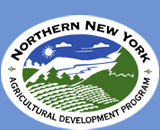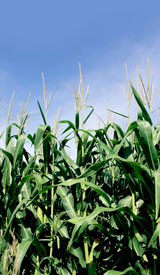September 17, 2010
Contact: Jeff Melkonian, Cornell University, 607-227-9172; Dr. Harold
Van Es, Cornell University, 607-255-5459, Michael Davis, Baker Farm,
Willsboro, 518-963-7492
NNY Research Supports Precision Farming Tool for Corn Growers
Northern New York - Farmers in Northern New York are pleased with the
robust 2010 corn crop, due in part to good weather and good field
management. The harvest in 2011 may be even better as more farmers adopt
the use of the field-specific precision nitrogen application Adapt-N.
The Cornell-built software was refined by three years of research on
farms in Northern New York.
“Corn gets nitrogen from a number of sources and there are many ways
nitrogen can get lost from the root zone as a result of weather-related
factors,” Cornell University Department of Crop and Soil Sciences Senior
Research Associate Jeff Melkonian says. “We now have the Adapt-N tool to
provide corn growers with more precise, field-specific nitrogen
recommendations based on the impact of early season weather.”
The farmer-driven Northern New York Agricultural Development Program was
among the funding partners for a multi-partner collaboration that
includes the Cornell University College of Agriculture and Life
Sciences; the Cornell Computational Agriculture Initiative, funded by
the US Department of Agriculture, at the Center for Advanced Computing
at Cornell; and the Northeast Regional Climate Center at Cornell.
Professor Harold van Es, Cornell University Crop and Soil Sciences
Department Chair, conceived of the idea for the Adapt-N tool and has
been instrumental in its development and acquiring funding support to
develop it.
van Es says, “Eighteen years of field research at the Cornell E.V. Baker
Agricultural Research Farm in Northern New York at Willsboro formed the
foundation for the development of this new tool, including analyses of
the environmental losses from fertilizer and manure applications.”
The collaboration has created and refined the Adapt-N tool that
accommodates year-to-year and field-to-field variability of nitrogen
availability.
For example, Melkonian says, “In warm weather, nitrogen mineralizes
faster from organic matter in the soil to become available to the corn,
while the opposite is true in colder weather. In a drier spring,
nitrogen mineralizes and remains in the root zone where the corn can
take it up, while in a wetter year the nutrient may leach out of reach
of the crop roots.”
van Es adds, “This is why we could manage nitrogen applications on corn
with only about plus or minus forty percent accuracy until now.”
Farmers enter latitude and longitude for their chosen field site, soil
texture, drainage, tillage, past manure application information, and
other data into the online tool at http://adapt-n.eas.cornell.edu.
Adapt-N works in tandem with Northeast Regional Climate Center data
(available on a 3mile x 3mile grid) and with a Precision Nitrogen
Management simulation model for corn growth and N uptake. The system
uses the data entered by the farmer to calculate a recommended optimal
sidedress nitrogen application rate.
Research to test the effectiveness of the Adapt-N tool took place on the
long-term no-till and plow-till plots at the 352-acre Cornell University
E. V. Baker Agricultural Research Farm along Lake Champlain at
Willsboro, NY.
Efficient use of only the precise amount of nitrogen resource needed
positively impacts corn yield and quality and farm profits, and reduces
nutrient losses to water and air. Using less fertilizer could mean less
time and fuel spent working a field,” says Baker Farm Manager Michael H.
Davis. “I highly recommend the use of the Adapt-N tool to growers who
typically apply sidedress nitrogen.”
Farmers interested in using Adapt-N must contact Melkonian at
jjm11@cornell.edu for a user ID and password entry.
Melkonian says, based on inquiries and feedback he has received, some
New York farmers have used Adapt-N with their 2010 corn crops. He adds
that the project has also received a lot of interest from Iowa farmers.
“The Iowa Soybean Association, crop consultants and individual farmers
have begun using Adapt-N and we are waiting on their first harvest data.
Iowa grows a lot of corn in rotation with soybeans and if this tool can
help them maintain their yields while using nitrogen more efficiently it
will have a huge impact there,” Melkonian says.
On-farm testing of the Adapt-N tool with New York farmers is expected to
begin in 2011 with funding from the NY Farm Viability Institute.
Institute Executive Director Tom Sleight says, “With the current
economic conditions, the Institute had to cut more than half of its
planned projects for 2011. The Adapt-N project survived the cut because
it is critical to New York’s agricultural, economic and environmental
interests.”
For more information on precision nutrient management in Northern New
York, visit the Northern New York Agricultural Development Program
website at www.nnyagdev.org.



